Antenna-Rectifier Co-design
The characteristic of rectennas following the E-G topology in Figure 2 is that the antenna is directly matched to the rectifier, rather than the 50Ω standard, which requires minimizing or eliminating the matching circuit to power the rectifier. This section reviews the advantages of SoA rectennas with non-50Ω antennas and rectennas without matching networks.
1. Electrically Small Antennas
LC resonant ring antennas have been widely used in applications where system size is critical. At frequencies below 1 GHz, the wavelength may cause standard distributed element antennas to occupy more space than the overall size of the system, and applications such as fully integrated transceivers for body implants particularly benefit from the use of electrically small antennas for WPT.
The high inductive impedance of the small antenna (near resonance) can be used to directly couple the rectifier or with an additional on-chip capacitive matching network. Electrically small antennas have been reported in WPT with LP and CP below 1 GHz using Huygens dipole antennas, with ka=0.645, while ka=5.91 in normal dipoles (ka=2πr/λ0).
2. Rectifier conjugate antenna
The typical input impedance of a diode is highly capacitive, so an inductive antenna is required to achieve conjugate impedance. Due to the capacitive impedance of the chip, high impedance inductive antennas have been widely used in RFID tags. Dipole antennas have recently become a trend in complex impedance RFID antennas, exhibiting high impedance (resistance and reactance) near their resonant frequency.
Inductive dipole antennas have been used to match the high capacitance of the rectifier in the frequency band of interest. In a folded dipole antenna, the double short line (dipole folding) acts as an impedance transformer, allowing the design of an extremely high impedance antenna. Alternatively, bias feeding is responsible for increasing the inductive reactance as well as the actual impedance. Combining multiple biased dipole elements with unbalanced bow-tie radial stubs forms a dual broadband high impedance antenna. Figure 4 shows some reported rectifier conjugate antennas.
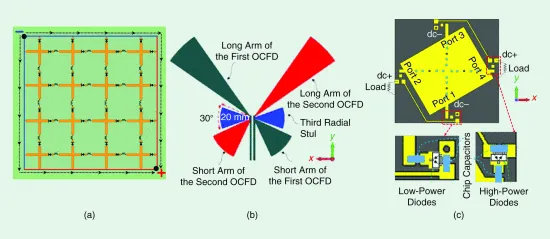
Figure 4
Radiation characteristics in RFEH and WPT
In the Friis model, the power PRX received by an antenna at a distance d from the transmitter is a direct function of the receiver and transmitter gains (GRX, GTX).

The antenna’s main lobe directivity and polarization directly impact the amount of power collected from the incident wave. Antenna radiation characteristics are key parameters that differentiate between ambient RFEH and WPT (Figure 5). While in both applications the propagation medium may be unknown and its effect on the received wave needs to be considered, knowledge of the transmitting antenna can be exploited. Table 3 identifies the key parameters discussed in this section and their applicability to RFEH and WPT.

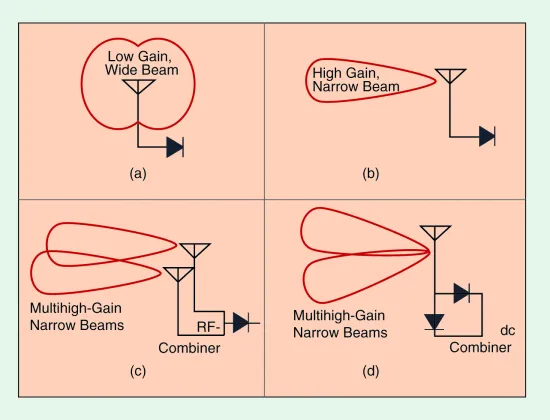
Figure 5
1. Directivity and Gain
In most RFEH and WPT applications, it is assumed that the collector does not know the direction of the incident radiation and there is no line-of-sight (LoS) path. In this work, multiple antenna designs and placements have been investigated to maximize the received power from an unknown source, independent of the main lobe alignment between the transmitter and the receiver.
Omnidirectional antennas have been widely used in environmental RFEH rectennas. In the literature, the PSD varies depending on the orientation of the antenna. However, the variation in power has not been explained, so it is not possible to determine whether the variation is due to the radiation pattern of the antenna or due to polarization mismatch.
In addition to RFEH applications, high-gain directional antennas and arrays have been widely reported for microwave WPT to improve the collection efficiency of low RF power density or overcome propagation losses. Yagi-Uda rectenna arrays, bowtie arrays, spiral arrays, tightly coupled Vivaldi arrays, CPW CP arrays, and patch arrays are among the scalable rectenna implementations that can maximize the incident power density under a certain area. Other approaches to improve antenna gain include substrate integrated waveguide (SIW) technology in microwave and millimeter wave bands, specific to WPT. However, high-gain rectennas are characterized by narrow beamwidths, making reception of waves in arbitrary directions inefficient. Investigations into the number of antenna elements and ports concluded that higher directivity does not correspond to higher harvested power in ambient RFEH assuming three-dimensional arbitrary incidence; this was verified by field measurements in urban environments. High-gain arrays can be limited to WPT applications.
To transfer the benefits of high-gain antennas to arbitrary RFEHs, packaging or layout solutions are utilized to overcome the directivity issue. A dual-patch antenna wristband is proposed to harvest energy from ambient Wi-Fi RFEHs in two directions. Ambient cellular RFEH antennas are also designed as 3D boxes and printed or adhered to external surfaces to reduce system area and enable multi-directional harvesting. Cubic rectenna structures exhibit higher probability of energy reception in ambient RFEHs.
Improvements to antenna design to increase beamwidth, including auxiliary parasitic patch elements, were made to improve WPT at 2.4 GHz, 4 × 1 arrays. A 6 GHz mesh antenna with multiple beam regions was also proposed, demonstrating multiple beams per port. Multi-port, multi-rectifier surface rectennas and energy harvesting antennas with omnidirectional radiation patterns have been proposed for multi-directional and multi-polarized RFEH. Multi-rectifiers with beamforming matrices and multi-port antenna arrays have also been proposed for high-gain, multi-directional energy harvesting.
In summary, while high-gain antennas are preferred to improve the power harvested from low RF densities, highly directional receivers may not be ideal in applications where the transmitter direction is unknown (e.g., ambient RFEH or WPT through unknown propagation channels). In this work, multiple multi-beam approaches are proposed for multi-directional high-gain WPT and RFEH.
2. Antenna Polarization
Antenna polarization describes the movement of the electric field vector relative to the antenna propagation direction. Polarization mismatches can lead to reduced transmission/reception between antennas even when the main lobe directions are aligned. For example, if a vertical LP antenna is used for transmission and a horizontal LP antenna is used for reception, no power will be received. In this section, reported methods for maximizing wireless reception efficiency and avoiding polarization mismatch losses are reviewed. A summary of the proposed rectenna architecture with respect to polarization is given in Figure 6 and an example SoA is given in Table 4.

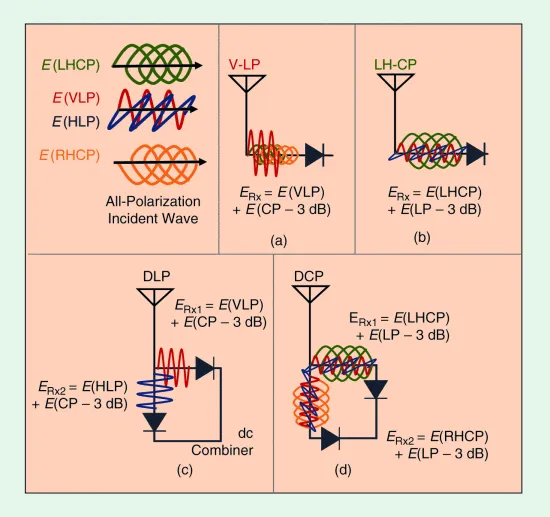
Figure 6
In cellular communications, linear polarization alignment between base stations and mobile phones is unlikely to be achieved, so base station antennas are designed to be dual-polarized or multi-polarized to avoid polarization mismatch losses. However, the polarization variation of LP waves due to multipath effects remains an unsolved problem. Based on the assumption of multi-polarized mobile base stations, cellular RFEH antennas are designed as LP antennas.
CP rectennas are mainly used in WPT because they are relatively resistant to mismatch. CP antennas are able to receive CP radiation with the same rotation direction (left-handed or right-handed CP) in addition to all LP waves without power loss. In any case, the CP antenna transmits and the LP antenna receives with a 3 dB loss (50% power loss). CP rectennas are reported to be suitable for 900 MHz and 2.4 GHz and 5.8 GHz industrial, scientific, and medical bands as well as millimeter waves. In RFEH of arbitrarily polarized waves, polarization diversity represents a potential solution to polarization mismatch losses.
Full polarization, also known as multi-polarization, has been proposed to completely overcome polarization mismatch losses, enabling the collection of both CP and LP waves, where two dual-polarized orthogonal LP elements effectively receive all LP and CP waves. To illustrate this, the vertical and horizontal net voltages (VV and VH) remain constant regardless of the polarization angle:
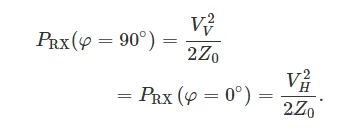
CP electromagnetic wave “E” electric field, where power is collected twice (once per unit), thereby fully receiving the CP component and overcoming the 3 dB polarization mismatch loss:
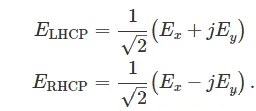
Finally, through DC combination, incident waves of arbitrary polarization can be received. Figure 7 shows the geometry of the reported fully polarized rectenna.
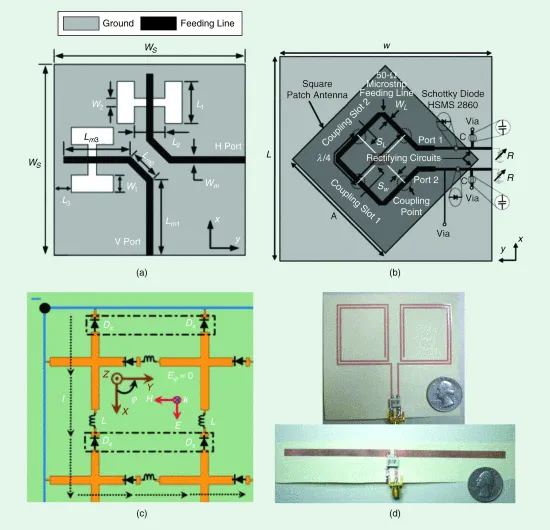
Figure 7
In summary, in WPT applications with dedicated power supplies, CP is preferred because it improves WPT efficiency regardless of the polarization angle of the antenna. On the other hand, in multi-source acquisition, especially from ambient sources, fully polarized antennas can achieve better overall reception and maximum portability; multi-port/multi-rectifier architectures are required to combine fully polarized power at RF or DC.
Summary
This paper reviews the recent progress in antenna design for RFEH and WPT, and proposes a standard classification of antenna design for RFEH and WPT that has not been proposed in previous literature. Three basic antenna requirements for achieving high RF-to-DC efficiency have been identified as:
1. Antenna rectifier impedance bandwidth for the RFEH and WPT bands of interest;
2. Main lobe alignment between transmitter and receiver in WPT from a dedicated feed;
3. Polarization matching between the rectenna and the incident wave regardless of angle and position.
Based on impedance, rectennas are classified into 50Ω and rectifier conjugate rectennas, with a focus on impedance matching between different bands and loads and the efficiency of each matching method.
The radiation characteristics of SoA rectennas have been reviewed from the perspective of directivity and polarization. Methods to improve gain by beamforming and packaging to overcome narrow beamwidth are discussed. Finally, CP rectennas for WPT are reviewed, along with various implementations to achieve polarization-independent reception for WPT and RFEH.
To learn more about antennas, please visit:
Post time: Aug-16-2024







